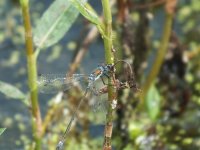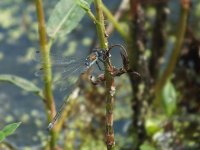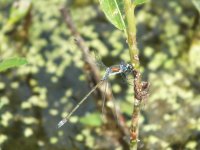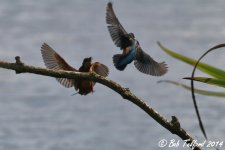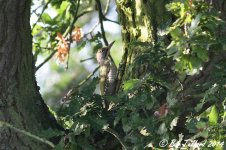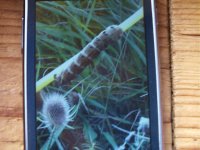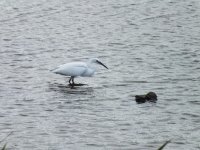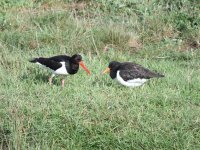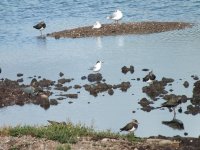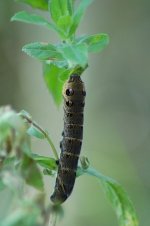-
Welcome to BirdForum, the internet's largest birding community with thousands of members from all over the world. The forums are dedicated to wild birds, birding, binoculars and equipment and all that goes with it.
Please register for an account to take part in the discussions in the forum, post your pictures in the gallery and more.
You are using an out of date browser. It may not display this or other websites correctly.
You should upgrade or use an alternative browser.
You should upgrade or use an alternative browser.
Upton Warren (21 Viewers)
- Thread starter andythomas
- Start date
More options
Who Replied?bob's_retired
Active member
11 August at Upton.
I really enjoyed my trip to Upton yesterday. Really good talking to people especially in the concrete hide. Highlight was obviously the hour with the Kingfishers, though the light was against us a lot of the time. For me also cathcing sight of a pair of Green Woodpeckers by the gate to the flashes.
Cheers,
Bob
I really enjoyed my trip to Upton yesterday. Really good talking to people especially in the concrete hide. Highlight was obviously the hour with the Kingfishers, though the light was against us a lot of the time. For me also cathcing sight of a pair of Green Woodpeckers by the gate to the flashes.
Cheers,
Bob
Attachments
upstarts1979
Well-known member
UW82
Well-known member
This caterpillar was found in the Broadmeadow reed bed today. Any ideas
Pic taken off Bob P's phone
Possibly Elephant Hawk Moth.
Des.
midlands birder
Well-known member
This caterpillar was found in the Broadmeadow reed bed today. Any ideas
Pic taken off Bob P's phone
Looks like an Elephant Hawk moth
Edit- Des got there first
Abbeybirder
Well-known member
Yep I would go with Elephant hawk moth as had one in the front garden 2 years ago and took it to Dudley Zoo where they sent me an e-mail 2 or 3 days later saying Elephant hawk moth
upstarts1979
Well-known member
Stone Snapper
Warrener till i snuff it
found an eye piece off a camera today if its yours let me know its in my car
forgetfulelephant
Well-known member
This caterpillar was found in the Broadmeadow reed bed today. Any ideas
Pic taken off Bob P's phone
Agree with the others on EHM. Had one near Lifestyles a few years back.
forgetfulelephant
Well-known member
UW82
Well-known member
Another great late afternoon and evening at Upton Warren on WeBS count day with good company and a nice selection of birds.
MOORS POOL
2 Little Egret, 2 Grey Heron, 2 Cormorant, 2 adult + 6 juvenile Mute Swan, 4 Greylag Geese, 90 Canada Geese, 1 Teal (plus 10 on North Moors as per Paul C), c20 Tufted Duck, 140 Mallard, 138 Coot, 10 Moorhen, 4 LBB Gull, 1 Herring Gull, c75 BH Gull, Common Tern - 5 adults + 1 juvenile + 2 young, GC Grebe - 2 adults + 1 juvenile + 3 young, Little Grebe - 8 adults + 8 juveniles + 2 young, Kingfisher, Hobby over the Education Reserve, Raven regularly over (minimum of 5 birds), possible Spotted Flycatcher calling from the NW corner of the North Moors.
5 juvenile Ruff circled but didnt land early afternoon as per Jason Turner
SAILING POOL
51 Mallard, 11 Coot, 2 adult + 3 juvenile GC Grebe
FLASHES
Wood Sand feeding in the delta (another find by Jason Turner :t, 11 Green Sand, 4 Common Sand, 294 Lapwing, 3 adult + 9 young Avocet, 2 adult + 1 young Oystercatcher, 2 Snipe, 23 Curlew, 2 juvenile Shelduck, 26 Teal, 4 juvenile Shoveler, juvenile Little Grebe, 27 Coot, 18 Moorhen, 3 LBB Gull, c1000 BH Gull by 8:30pm, 21 Greylag Geese (including 1+ juvenile), 2 Raven over, juvenile Willow Warbler as per Dave W, 2 juvenile Med Gulls - 1 advanced bird with small metal leg ring, the other even more advanced (getting towards first winter) with a completely black bill and black legs, Barn Owl over fields east and south of the Flashes at approx 9pm.
With today's Ruff, Barn Owl and Wood Sandpiper, plus late news of a Common Gull briefly in the Flashes' roost on Monday night, the August total advances further to 94 species.
Phil, you can cross Redshank off for the month, there's one at the Flashes.
Des.
upstarts1979
Well-known member
Here's the pic of the one I found.
that looks like it Rob . thanks boys
UW82
Well-known member
Today's highlights:
FLASHES:
Redshank-------------------Dunlin
LRP (juv)-------------------Green Sand (5)
Common sand (3)-----------Avocet (3 ad + 9 juvs)
Curlew (22)-----------------Oystercatcher (2 ad + juv)
Lapwing (c250)-------------Snipe (2)
Shelduck (2 juvs)-----------Teal (22)
Gadwall (1)-----------------Shoveler (2)
Little Grebe (1)-------------Raven (4)
Peregrine-------------------Buzzard (9 in close proximity)
Swift (1)-------------------Kingfisher
Pheasant-------------------Common Gull (sub-ad)
B H Gull (c600)-------------Whitethroat
Redstart (m) in transmitter field along hedge/fence.
Common Tern (2ad + 2 juvs)
MOORS:
Little Egret (2)--------------Sedge Warbler
Little Grebe (6)--------------Common Tern (8)
Swallow (c15)---------------B H Gull (c250)
Herring Gull (2)--------------Cormorant (2)
Kingfisher-------------------Sparrowhawk
Des.
FLASHES:
Redshank-------------------Dunlin
LRP (juv)-------------------Green Sand (5)
Common sand (3)-----------Avocet (3 ad + 9 juvs)
Curlew (22)-----------------Oystercatcher (2 ad + juv)
Lapwing (c250)-------------Snipe (2)
Shelduck (2 juvs)-----------Teal (22)
Gadwall (1)-----------------Shoveler (2)
Little Grebe (1)-------------Raven (4)
Peregrine-------------------Buzzard (9 in close proximity)
Swift (1)-------------------Kingfisher
Pheasant-------------------Common Gull (sub-ad)
B H Gull (c600)-------------Whitethroat
Redstart (m) in transmitter field along hedge/fence.
Common Tern (2ad + 2 juvs)
MOORS:
Little Egret (2)--------------Sedge Warbler
Little Grebe (6)--------------Common Tern (8)
Swallow (c15)---------------B H Gull (c250)
Herring Gull (2)--------------Cormorant (2)
Kingfisher-------------------Sparrowhawk
Des.
Stone Snapper
Warrener till i snuff it
Today's highlights:
FLASHES:
Redshank-------------------Dunlin
LRP (juv)-------------------Green Sand (5)
Common sand (3)-----------Avocet (3 ad + 9 juvs)
Curlew (22)-----------------Oystercatcher (2 ad + juv)
Lapwing (c250)-------------Snipe (2)
Shelduck (2 juvs)-----------Teal (22)
Gadwall (1)-----------------Shoveler (2)
Little Grebe (1)-------------Raven (4)
Peregrine-------------------Buzzard (9 in close proximity)
Swift (1)-------------------Kingfisher
Pheasant-------------------Common Gull (sub-ad)
B H Gull (c600)-------------Whitethroat
Redstart (m) in transmitter field along hedge/fence.
Common Tern (2ad + 2 juvs)
MOORS:
Little Egret (2)--------------Sedge Warbler
Little Grebe (6)--------------Common Tern (8)
Swallow (c15)---------------B H Gull (c250)
Herring Gull (2)--------------Cormorant (2)
Kingfisher-------------------Sparrowhawk
Des.
Just to add 3 sand martins moors pool
upstarts1979
Well-known member
mike has got a juv med gull at the Flashes tonight
Last edited:
Phil Andrews
It's only Rock and Roller but I like it

Two of them? 8-P Will be interesting to learn if it was either of the juvs that was present on Sunday
Last edited:
Phil Andrews
It's only Rock and Roller but I like it

15th August
Happy Monty's Day John (fifth anniversary) B B
B  B
B  B
B  B
B 
Happy Monty's Day John (fifth anniversary) B
Phil Andrews
It's only Rock and Roller but I like it

The changing face of breeding waders
With the last three broods of Avocet at the Flashes now fledged, the total number of Avocet raised this year is confirmed at 23. It is interesting to compare wader fledging totals for the 12 years Avocet have been breeding with the same period prior to 2003:
2003-2014
Avocet - 115
Oystercatcher - 27
Little Ringed Plover - 21
Lapwing - 20
Redshank - 7
1991-2002
Avocet - 0
Oystercatcher - 3
Little Ringed Plover - 46
Lapwing - 67
Redshank - 6
Oystercatcher has now become firmly established whilst Redshank is only a very occasional breeder (last successful in 2008). The long term decline of LRP and particularly Lapwing is very worrying though, especially as 11 of the 20 Lapwing from the last 12 years were produced the first two years of that period (2003 and 2004); likewise 14 of the 21 LRP raised from the current 12 year period also came from those first two years. The reasons are complicated and many-fold; three that I would highlight would be the pressure at the Flashes created by the breeding Avocets and BHG, the loss of prime shoreline at the Flashes due to encroaching phragmites and the degradation of Amy's Marsh at the Moors Pool.
With the last three broods of Avocet at the Flashes now fledged, the total number of Avocet raised this year is confirmed at 23. It is interesting to compare wader fledging totals for the 12 years Avocet have been breeding with the same period prior to 2003:
2003-2014
Avocet - 115
Oystercatcher - 27
Little Ringed Plover - 21
Lapwing - 20
Redshank - 7
1991-2002
Avocet - 0
Oystercatcher - 3
Little Ringed Plover - 46
Lapwing - 67
Redshank - 6
Oystercatcher has now become firmly established whilst Redshank is only a very occasional breeder (last successful in 2008). The long term decline of LRP and particularly Lapwing is very worrying though, especially as 11 of the 20 Lapwing from the last 12 years were produced the first two years of that period (2003 and 2004); likewise 14 of the 21 LRP raised from the current 12 year period also came from those first two years. The reasons are complicated and many-fold; three that I would highlight would be the pressure at the Flashes created by the breeding Avocets and BHG, the loss of prime shoreline at the Flashes due to encroaching phragmites and the degradation of Amy's Marsh at the Moors Pool.
Last edited:
wheatearlp
Well-known member

Two of them? 8-P Will be interesting to learn if it was either of the juvs that was present on Sunday
Only one juv Med. Gull and that seemed to disappear by c.19.45. It could have been hiding amongst the 1,000 or so BHGs that were present, but fairly extensive searching failed to locate it. Many of the BHGs headed to the third flash arond 20.30-21.00 where they seemed to be feeding on an insect hatch of some sort.
Waders present were Avocet (3 ad, 9 juv), Oystercatcher (2 ad, 1 juv), LRP (1 juv) Lapwing (c.150), Dunlin (2), Snipe (4), Curlew (21), Green Sand (6), Common Sand (3).
The two juvenile Shelducks were also still present, Teal were uncounted but there was in excess of a dozen. Five Common Terns joined the roost (4 ad, 1 juv). Sadly no owls but Gert saw both Roe Deer (field to north-east of pools) and Badger (2 in sewage works compound).
The five Great Crested Grebes were still present on the Sailing Pool.
Similar threads
- Replies
- 1
- Views
- 1K
Users who are viewing this thread
Total: 22 (members: 0, guests: 22)




